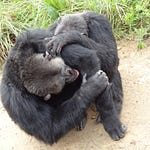How Power Works in a Bonobo Society
In the animal kingdom, dominance often wears a male face. But in bonobo societies, the rules of engagement are different. Here, females frequently hold the upper hand, despite being smaller than their male counterparts.
A new long-term study spanning thirty years and six bonobo communities in the Democratic Republic of Congo sheds light on why. The findings, published in Communications Biology1 by Martin Surbeck and colleagues, suggest that the key to female dominance isn't brute strength, nor is it subtle reproductive strategies — it’s coalition-building.
As the authors put it:
"Female coalition formation is a behavioral tool for females to gain power over males."
Rather than outmuscling or outmaneuvering the males individually, female bonobos are seizing power by banding together.
Testing the Origins of Female Power
Researchers tested three major theories to explain female dominance in bonobos:
Self-Organization Hypothesis: The idea that winning or losing conflicts builds momentum, with groups of males weakening themselves through internal competition.
Reproductive Control Hypothesis: The notion that if females synchronize fertility signals or make ovulation hard to detect, it reduces male mating monopolies.
Female Coalition Hypothesis: The idea that cooperation among females itself elevates their power over males.
Only one of these stood up to scrutiny.
Across more than 1,700 recorded conflicts, females formed coalitions that targeted males in 85% of the cases. These coalitions were directly linked to an increase in female dominance across all six communities studied. As Surbeck and colleagues summarized:
"Communities and years in which adult females formed more coalitions corresponded to females winning more dyadic conflicts against males and ranking higher than males."
In contrast, neither male-heavy community composition nor reproductive synchronization explained shifts in power dynamics.
A Different Kind of Strength
Female bonobos aren't simply outnumbering males in fights. They are leveraging a different kind of strength — social cooperation.
"Despite male-biased sexual dimorphism, female bonobos outrank about 70% of the adult males in their communities," the researchers found. "In nearly half of the study years, a female occupied the highest rank."
This is a sharp departure from chimpanzee societies, where male dominance is nearly absolute.
Interestingly, even male size advantage and male philopatry (where males stay in their birth group while females migrate) were not enough to suppress the coalition effect.
What Bonobo Coalitions Tell Us About Evolution
The female-driven power structure of bonobos offers a provocative glimpse into alternative evolutionary pathways. Across mammals, female dominance usually coincides with traits like body size equality (as seen in lemurs) or extreme reproductive strategies (like those of spotted hyenas).
In bonobos, something subtler seems to be at play: the strategic use of alliances, social bonds, and collective action.
Coalitions allowed female bonobos not just to fend off male aggression but to reshape the social order itself — a feat few other mammals have achieved so systematically.
Broader Implications
The findings don't only deepen understanding of bonobo society. They also raise broader questions about the roots of human social organization. After all, Pan paniscus, the bonobo, is one of humanity’s closest living relatives.
If social alliances helped shift power dynamics in bonobos, could similar mechanisms have influenced early human societies — particularly in matrilineal or cooperative communities?
As the study notes:
"Mutual social support among unrelated females can profoundly shape intersexual dominance dynamics, even in species without female philopatry."
It’s a reminder that the quiet strength of cooperation can sometimes upend even the most seemingly natural hierarchies.
Related Research
Here’s some additional related research you might find useful:
Davidian, E., Surbeck, M., Lukas, D., Kappeler, P. M., & Huchard, E. (2022). The eco-evolutionary landscape of power relationships between males and females. Trends in Ecology & Evolution, 37(8), 706–718. https://doi.org/10.1016/j.tree.2022.03.007
Vullioud, C., et al. (2018). Social support drives female dominance in the spotted hyena. Nature Ecology & Evolution, 2, 95–102. https://doi.org/10.1038/s41559-017-0364-2
Surbeck, M., & Hohmann, G. (2013). Intersexual dominance relationships and the influence of leverage on the outcome of conflicts in wild bonobos (Pan paniscus). Behavioral Ecology and Sociobiology, 67(11), 1767–1780. https://doi.org/10.1007/s00265-013-1594-8
Surbeck, M., Cheng, L., Kreyer, M., Gort, G., Mundry, R., Hohmann, G., & Fruth, B. (2025). Drivers of female power in bonobos. Communications Biology, 8(1), 550. https://doi.org/10.1038/s42003-025-07900-8










